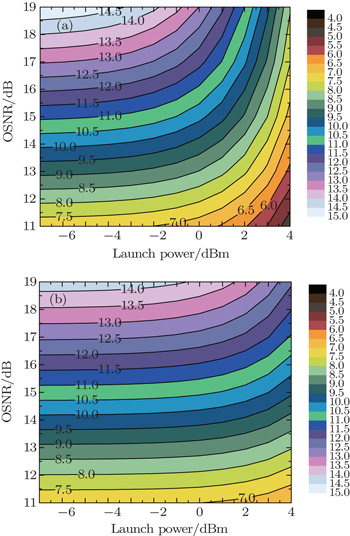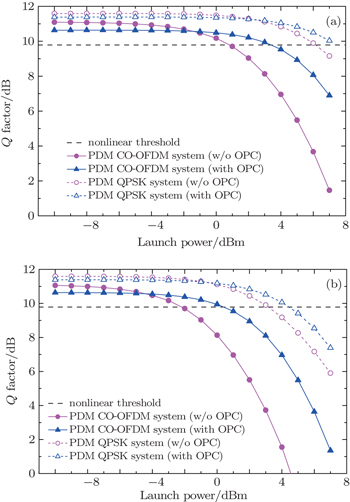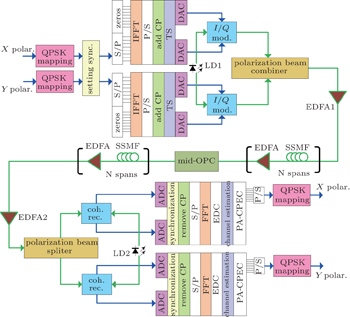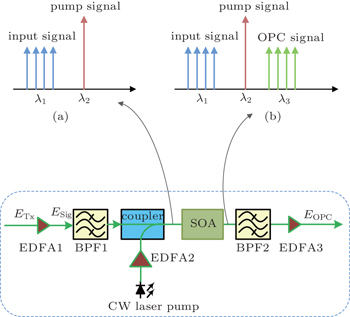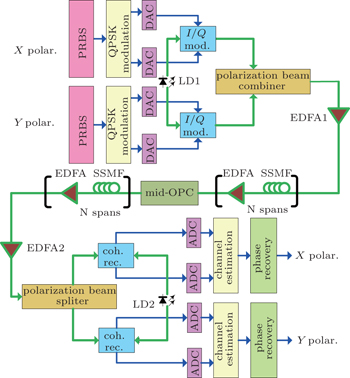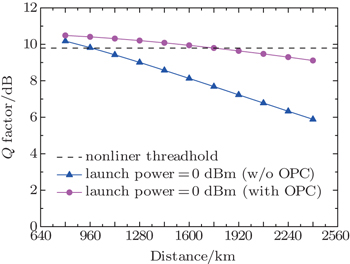Comparison of the compensation effects of fiber nonlinear impairments with mid-span optical phase conjugation between PDM CO-OFDM system and PDM QPSK system
State Key Laboratory of Information Photonics and Optical Communications Beijing University of Posts and Telecommunications, Beijing 100876, China
† Corresponding author. E-mail: qiao@bupt.edu.cn
Project supported by the National Natural Science Foundation of China (Grant Nos. 61271192, 61427813, and 61331010) and the National Basic Research Program of China (Grant No. 2013AA013401).
1. IntroductionCoherent optical orthogonal frequency division multiplexing (OFDM) has been extensively investigated and adopted in optical communication due to its superior performance like high spectral efficiency, and robustness against channel impairments in fiber medium.[1,2] Polarization division multiplexing is a technology that utilizes the polarization character of light to easily double the system capacity while keeping the signal bandwidth unchanged at a moderate complexity level. Because of those benefits, PDM CO-OFDM system has attracted significant attention in long-haul and high-speed transmission.[3] However, the intrinsic nonlinearity impairments in fiber link affect the system seriously unless the optical power is kept low, but low optical power will constrain the system transmission distance and performance.[4] Therefore, compensation of fiber nonlinearity is extremely important for achieving better system performance in long-haul transmission.[5,6]
Some methods have already been proposed to compensate for nonlinear impairments such as digital back propagation (BP) and pre-compensation,[6–9] but the computational complexity is relatively high. Optical phase conjugation (OPC) is a well-known process whereby an optical signal is propagated through a nonlinear medium in the presence of a pump beam to create a ‘phase conjugate’ signal, typically at a shifted frequency/energy. Optical phase conjugation (OPC) which can realize the spectral inversion was proposed first by Yariv et al. in 1979 to compensate for the chromatic dispersion.[10] Afterward, OPC has been widely used in nonlinear impairment compensation incurred by Kerr effect since Kerr effect as a kind of deterministic nonlinear effect is the main source of impairment in high bit-rate transmission system.[11–13] Mid-span spectral inversion (MSSI), which uses OPC near the middle of the link, has been shown to be effective for nonlinearity compensation for intensity modulated systems.[14,15] For CO-OFDM system OPC that is placed in the middle of the link has already shown its effectiveness on nonlinear impairment compensation.[15] However, whether the SC PDM QPSK system has better performance than the PDM CO-OFDM has not been confirmed yet.
In this paper, we use mid-span OPC based on FWM effect that is introduced by an SOA to 112-Gb/s PDM CO-OFDM system and SC PDM QPSK system to compensate for the fiber nonlinear impairments. The simulation results demonstrate that the PDM CO-OFDM system with mid-span OPC has better compensation effect than SC PDM QPSK system. In the PDM CO-OFDM system, improvements of launch power by 2.5 dBm and transmission distance by 800 km with respect to the nonlinear threshold (Q = 9.8 dB) can be achieved, which have significant value for long haul transmission system. However, the improvement of launch power achieved in SC PDM QPSK system is only 1.5 dBm. Therefore, applying OPC to PDM CO-OFDM system is more useful.
2. OPC and simulation systemTo test the optimized OPC configuration, numerical simulations are performed in 112-Gb/s PDM CO-OFDM system. VPIsystem VPItransmission Maker is used for simulations, and the schematic diagram of this system is shown in Fig. 1. Two uncorrelated pseudo random binary sequences (PRBSs) with the order of 32 are employed: each for one polarization, and from which 524288 bits are chosen and mapped into QPSK constellation before inverse fast Fourier transform (IFFT). We do zero padding (ZP) with a ratio of 1/4 before the IFFT process to avoid the influence of unideal filters. Afterwards, IFFT cyclic prefix (CP) with a ratio of 1/16 is added to remove the channel dispersion induced inter-symbol interference (ISI) and inter-carrier interference (ICI). The baseband OFDM signal is then converted to the analog domain by the digital-to-analog converter (DAC) and directly to the optical domain by an optical in-phase quadrature (IQ) modulator. After that the two polarized signals are mixed by polarization beam combiner (PBC).
We employ a transmission link composed of multiple spans, each including 80-km-long standard single mode fiber (SSMF) followed by an erbium-doped fiber amplifier (EDFA). The parameters of SSMF are fiber loss α = 0.2 dB/km, dispersion coefficient D=16 ps/nm/km dispersion slope of 0.08 ps/nm2/km, and nonlinearity coefficient γ = 1.3/W·km. On the receiver side, the polarization beam splitter (PBS) will first split de-multiplexed optical signal into two polarization branches, and then coherent detection is used. After symbol synchronization, FFT, electronic dispersion compensation (EDC), channel estimation, and pilot-assisted common phase error compensation (PA-CPEC) are performed, the received signal can be achieved.[16,17]
The implementation condition for nonlinear compensation by OPC is proposed as:[18]



Equation (
1) is the condition of chromatic dispersion compensation by OPC and equation (
2) is the condition of Kerr effect compensation by OPC, where
Ds j (
j = 1,2) is the dispersion parameter of fiber
j,
Lj (
j = 1,2) is the length of fiber
j,
Pj (
j = 1,2) is the path-averaged optical power in fiber
j, and
γj (
j = 1,2) is the nonlinearity coefficient of fiber
j. Equations (
1) and (
2) indicate the dispersion and nonlinearity compensation conditions, respectively.
[18]The condition in Eq. (2) must be satisfied in order to achieve the best compensation effect of OPC. In a mid-span OPC system, the nonlinear coefficients γj and lengths Lj before and after OPC are the same, so we only need to ensure the path-average optical powers of the two half spans to be the same. The OPC placed in the the middle of the link realizes the function of mid-span spectral inverse (MSSI) and its details are shown in Fig. 2. The input signal ETx with wavelength λ1 = 1550 nm is enhanced by EDFA1 then by band pass filter 1 (BPF1). After that, the signal Esig is coupled with a pump signal Epump with wavelength λ2 = 1552 nm and the signal spectra are shown in Fig. 2(a). Then the signals are fed into a 1-nm-long SOA to produce the FWM effect. The output signal spectra after SOA are shown in Fig. 2(b), and the signals then pass through BPF2 to remove the pump and original signals and output the OPC signal EOPC (λ3 = 1554 nm). In order to achieve the best compensation effect of OPC, the condition in Eq. (2) must be satisfied. In a mid-span OPC system, the nonlinear coefficients γj and lengths Lj before and after OPC are the same, so we only need to ensure that the path-average optical power of the two half spans are the same. In this paper, we set the signals Esig and Epump to be −2 dBm and 11 dBm, respectively. Then the OPC signal transmits through the remaining half of the total spans.
In Table 1, the basic parameters of the two simulation systems are listed. In each span, the length of SMF is 80 km, and at least 10 spans will be simulated to achieve the obvious nonlinear impairment effect.
Table 1.
Table 1.
 Table 1. Basic parameters of simulation platform. .
| Parameters |
Value |
| Esig |
−2 dBm |
| Epump |
11 dBm |
| Current injected into SOA |
300 mA |
| Table 1. Basic parameters of simulation platform. . |
The schematic diagram of 112-Gb/s SC PDM QPSK system is much simpler than that of PDM CO-OFDM system and it is shown in Fig. 3. They have the same behavior as the original electrical transmitting signal composed of two branches is converted to optical domain by I/Q modulators and then the two branches are combined into one branch by PBC. The configurations of optical fiber links in the two systems are exactly the same. On the receiver side, the required operations are polarization de-multiplexing coherent detection, ADC conversion, channel estimation and phase recovery. Then we can obtain the received signal.
3. Simulation resultsFigure 4 shows the contour maps of Q factor against OSNR and launch power injected into the first fiber span when transmission distance is 800 km in PDM CO-OFDM system. Figure 4(a) is for the system without OPC and figure 4(b) is for the system with OPC. When the launch power is low, the main effect on system performance is amplified spontaneous emission (ASE) noise which is a linear impairment. Therefore, the larger the OSNR, the larger the system Q factor will be. As the launch power exceeds some degree, nonlinear effect becomes the main factor influencing the system performance, and the value of Q decays severely no matter whether the OSNR is high or low as the launch power increases.
It can be seen in Figs. 4(a) and 4(b) that there is a flat area of Q within a certain range of launch power and the flat area in Fig. 4(b) is larger than that in Fig. 4(a), which means that compared with the system without mid-span OPC, the system with mid-span OPC can support a wider range of launch power while keeping the system performing in a relatively linear region under the same OSNR condition, in other words, can support longer transmission distance. In order to take nonlinear threshold as a reference, OSNR will be set to be 15 dB in the following simulations.
Figure 5 shows the simulated Q factors with respect to different launch power injected into the first fiber span when OSNR = 15 dB. Figure 5(a) shows the results after 800 km transmission and figure 5(b) displays the results after 1600-km transmission. The solid lines represent the simulation results obtained in PDM CO-OFDM system and the dashed lines denote the results obtained in SC PDM QPSK system. When the launch power is low, the nonlinear effect of system is not obvious, so the Q values keep flat in both of the systems. Since OPC is realized by FWM and some of the new frequency products fall partially on the OPC band and this part cannot be filtered out by BPF2,[19,20] this begets some impairments. We can see that this kind of impairment in PDM CO-OFDM system is more obvious than in SC PDM QPSK system as OFDM system is a multiple-carrier system which is more sensitive to FWM effect than single carrier system. However, as launch power increases, nonlinear effect becomes the main factor that affects system performance and the compensation effect of OPC becomes more and more obvious. As a result, an improvement of launch power with respect to nonlinear threshold (Q = 9.8 dB) is achieved by nearly 2.5 dBm in PDM CO-OFDM system and 1.5 dBm in SC PDM QPSK system for 800-km-long fiber link and 1600-km-long fiber link. From the compensation we can see that the compensation effect of OPC in PDM CO-OFDM is better than that in SC PDM QPSK system. Therefore, it is more worthy to adopt mid-span OPC in PDM CO-OFDM than in SC PDM QPSK system and 2.5 dBm improvement will have a significant value in extending the transmission distance of system.
Figure 6 demonstrates the simulated Q factors with respect to transmission distance in SC PDM QPSK system. In order to show the effectiveness of mid-span OPC clearly, the launch power is set to be 0 dBm. The result shows that the performance of the system without mid-span OPC decays faster than that of the system with mid-span OPC as the transmission distance increases. The larger the transmission distance, the better the compensation effect of mid-span OPC will be. Figure 6 shows that an improvement in transmission distance of 800 km with respect to nonlinear threshold can be achieved.
4. Conclusions and perspectivesIn this paper, we present the simulations of compensation effectiveness of fiber nonlinearity in 112-Gb/s PDM CO-OFDM system by a mid-span OPC based on FWM effect that is introduced by SOA and make a comparison of the compensation effect between PDM CO-OFDM system and SC PDM QPSK system. The simulations demonstrate that the system with mid-span OPC can efficiently extend the linear working region of the system and improve the launch power by 2.5 dBm in PDM CO-OFDM system and 1.5 dBm in SC PDM QPSK system for 800-km and 1600-km transmission distances. It is more useful to adopt mid-span OPC in PDM CO-OFDM system. When setting the OSNR to be 15 dB and launch power injected into the first span to be 0 dBm, an improvement of 800-km transmission distance with respect to the nonlinear threshold (Q = 9.8 dB) can be achieved in PDM CO-OFDM system. The system with mid-span OPC can efficiently compensate for the nonlinear impairments in fiber and extend the transmission distance.



